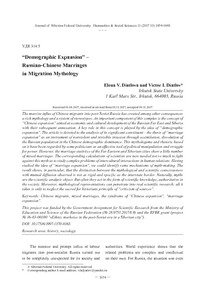“Demographic Expansion” – Russian-Chinese Marriages in Migration Mythology
Скачать файл:
URI (для ссылок/цитирований):
https://elib.sfu-kras.ru/handle/2311/67832Автор:
Diatlova, Elena V.
Diatlov, Victor I.
Дятлова, Е.В.
Дятлов, В.И.
Дата:
2017-11Журнал:
Журнал Сибирского федерального университета. Гуманитарные науки. Journal of Siberian Federal University. Humanities & Social Sciences;2017 10 (11)Аннотация:
The massive influx of Chinese migrants into post-Soviet Russia has created among other consequences a rich mythology and a system of stereotypes. An important component of this complex is the concept of “Chinese expansion” aimed at economic and cultural development of the Russian Far East and Siberia with their subsequent annexation. A key role in this concept is played by the idea of “demographic expansion”. The article is devoted to the analysis of its significant constituent – the thesis of “marriage expansion” as an instrument of nonviolent and invisible invasion through assimilation, dissolution of the Russian population in the Chinese demographic dominance. This mythologeme and rhetoric based on it have been regarded by some politicians as an effective tool of political manipulation and struggle for power. However, the marriage statistics of the Far Eastern and Siberian cities show a little number of mixed marriages. The corresponding calculations of scientists are now needed not so much to fight against this myth as to study complex problems of intercultural interactions in human relations. Having studied the idea of “marriage expansion”, we could identify some mechanisms of myth-making. The result shows, in particular, that the distinction between the mythological and scientific consciousness with mutual diffusion observed is not as rigid and specific as the interstate border. Naturally, myths are the scientific analysis object. But often they act in the form of scientific knowledge, authoritative in the society. Moreover, mythological representations can penetrate into real scientific research; all it takes is only to neglect the sacred for historians principle of “criticism of sources” Массовый приток китайских мигрантов в постсоветскую Россию породил, наряду с другими
последствиями, богатую мифологию и систему стереотипов. Важной составной частью этого
комплекса стала концепция «китайской экспансии», ставящей целью экономическое и культурное освоение российского Дальнего Востока и Сибири с их последующей аннексией. Ключевую роль в этой концепции играет идея демографической экспансии». Статья посвящена анализу
ее важной составной части – тезису о «брачной экспансии» как инструменте ненасильственного и невидимого вторжения посредством ассимиляции, растворения российского населения
в китайском демографическом море. Эта мифологема и основанная на ней риторика расценивались некоторыми политиками в качестве эффективного инструмента политического манипулирования и борьбы за власть. Однако брачная статистика дальневосточных и сибирских городов показывает ничтожное количество смешанных браков. Соответствующие подсчеты
ученых нужны теперь не столько для борьбы против этого мифа, сколько для изучения сложных проблем межкультурных взаимодействий на уровне человеческих отношений. Изучение идеи «брачной экспансии» позволяет выявить некоторые механизмы мифотворчества. Оно показывает, в частности, что грань между мифологическим и научным сознанием не такая жестокая
и определенная, как межгосударственная граница. Наблюдается взаимная диффузия. Естественно, что мифы являются предметом научного анализа, но зачастую они выступают в форме авторитетного в обществе научного знания. Более того, мифологические представления могут проникать и в настоящие научные исследования – стоит только позабыть о сакральном для историков принципе «критики источников»
Коллекции:
Метаданные:
Показать полную информациюСвязанные материалы
Показаны похожие ресурсы по названию, автору или тематике.
-
Dynamics of Nationalities Policy in USSR and their Manifestations in the Daily Living of Citizens: on the Phenomenon of the Diffusion of Interethnic Marriages
Lourié, Svetlana V.; Лурье, С.В. (Сибирский федеральный университет. Siberian Federal University, 2018-05)The article analyses the history of Nationaities Policy in USSR on its refraction to the private life of citizens, in the area of marital relations and ethnic self-identity of descendants. There are some graphical models ... -
Китайский Хабаровск: роль мигрантов в формировании городских пространств
Леонтьева, Э. О.; Ван На; Leonteva, Elvira O.; Van Na (Journal of Siberian Federal University. Сибирский федеральный университет, 2024-10)В статье на основе эмпирического материала рассматриваются сферы присутствия китайских мигрантов в российских городах, которые раньше находились на периферии исследовательского интереса, такие как общепит, бытовые ... -
Basic Concepts of Chinese National Religious and Philosophical Doctrines: an Introduction to Social Philosophical Study of Chinese Society
Sorokopud, Sergey N.; Сорокопуд, С.Н. (Сибирский федеральный университет. Siberian Federal University., 2014-03)The notion of basic concept of culture is substantiated in the article. A new definition of the concept is given. The history of formation of the notion concept, its differences from the category and concepts are previously ... -
Socio-Philosophical Analysis of the Basic Concepts Outlined in His Treatise Tao Te Ching, Based on the Author’s Translation-Interpretation
Sorokopud, Sergey N.; Сорокопуд, С.Н. (Сибирский федеральный университет. Siberian Federal University., 2014-01)The article presents the results of a new (authorized) translation of the ancient Chinese text by Lao Tzu Tao Te Ching. This ancient text in the world of science is a representative of basic concepts of Chinese culture, ... -
The National and the International in Three Works of Contemporary Chinese Artists
Sitnikova, Aleksandra A.; Ситникова, А.А. (Сибирский федеральный университет. Siberian Federal University, 2020-06)The article formulates and analyses a hypothesis, according to which, thanks to modern postmodern art, a single international visual language was formed in the late 20th – early 21st centuries, and previously mysterious ...

